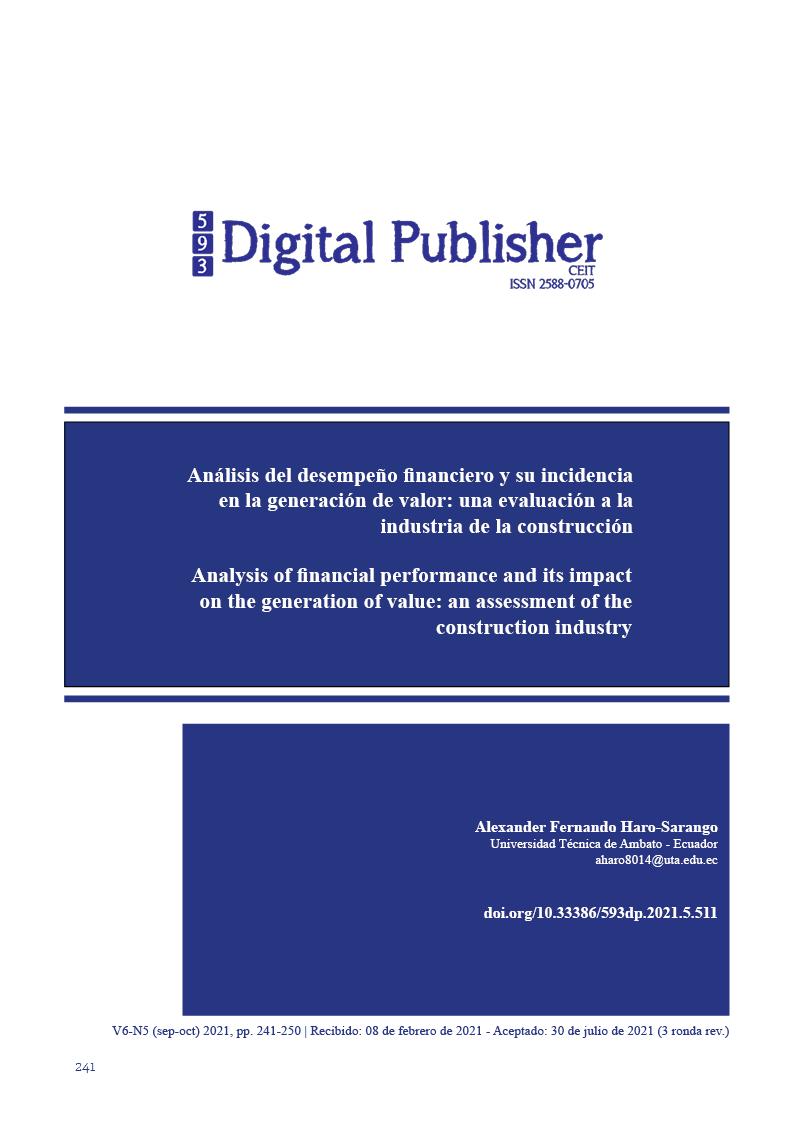Analysis of financial performance and its impact on the generation of value: an assessment of the construction industry
Main Article Content
Abstract
The crisis has led to the disappearance of many companies worldwide, even more when they have a low level of capital concentration or have no support in other organizations, however, the construction sector is an area with a high level of comprehensive development, this has unique attributes that some sectors manage it in low proportion, which are the volume of capital and the magnificent management administration, however, being an organization will always have risks attached to its function, ie, it does not exempt liquidity and insolvency risks, there have been fortuitous events that have made impossible the development of this sector, However, being an organization, it will always have risks attached to its function, that is to say, it does not exempt from liquidity and insolvency risks, there have been fortuitous events that have made the development of this sector impossible, in several countries the temporary crises forged these companies to award a higher criterion of adaptability to changes, for such arguments this study seeks to analyze the factors that influence the financial performance and the generation of economic value; for its execution the liquidity, solvency and management ratios will be used against variables of profitability on assets and equity (ROA and ROE), the development and analysis will be with the statistic of fixed and random effects, not without first developing a Hausman test that allows choosing the appropriate model for these variables; the study will be developed in three years (2017, 2018, 2019 and 2020) after observation and correction of the level of variability; the variable that awarded greater significance in the study of economic value is the indebtedness, this with a level p<0. 001 determines a value with a high level of affinity. Indebtedness is a transcendental variable in several studies, certain authors allude that the high concentration of this could be detrimental to sustainability, on the other hand, explicit arguments mention that everything depends on the line of business and the efficiency with which these third-party resources are managed.
Downloads
Article Details

This work is licensed under a Creative Commons Attribution-NonCommercial-ShareAlike 4.0 International License.
1. Derechos de autor
Las obras que se publican en 593 Digital Publisher CEIT están sujetas a los siguientes términos:
1.1. 593 Digital Publisher CEIT, conserva los derechos patrimoniales (copyright) de las obras publicadas, favorece y permite la reutilización de las mismas bajo la licencia Licencia Creative Commons 4.0 de Reconocimiento-NoComercial-CompartirIgual 4.0, por lo cual se pueden copiar, usar, difundir, transmitir y exponer públicamente, siempre que:
1.1.a. Se cite la autoría y fuente original de su publicación (revista, editorial, URL).
1.1.b. No se usen para fines comerciales u onerosos.
1.1.c. Se mencione la existencia y especificaciones de esta licencia de uso.
References
Banco Central del Ecuador. (2020, noviembre 30). La economía ecuatoriana se recuperará 3,1% en 2021. https://www.bce.fin.ec/index.php/boletines-de-prensa-archivo/item/1394-la-economia-ecuatoriana-se-recuperara-3-1-en-2021
CAF. (2018). Título. La Infraestructura en el Desarrollo Integral de América Latina—IDEAL 2015-2016. VOLUMEN SECTORIAL, 4, 272.
Cámara de Industrias y Producción. (2020, abril 10). Se requieren soluciones diferentes y urgentes para preservar el empleo en el Ecuador. CIP - Cámara de Industrias y Producción. https://www.cip.org.ec/2020/04/09/se-requieren-soluciones-diferentes-y-urgentes-para-preservar-el-empleo-en-el-ecuador/
Comamala, J. P. (2014). Gestión Financiera (GRADO SUPERIOR). Grupo Editorial RA-MA.
Debitoor. (2021). Rotación de activos—¿Qué es la rotación de activos? https://debitoor.es/glosario/rotacion-de-activos
Domínguez, G. B. (1998). CREACIÓN Y DESTRUCCIÓN DE LA BURBUJA INMOBILIARIA EN ESPAÑA. 18.
Echevarría, S. G. (1994). Introducción a la economía de la empresa. Ediciones Díaz de Santos.
Garcia, J., Cazallo, A., Barragan, C. E., Mercado, M., Olarte, L., & Meza, V. (2019). Indicadores de Eficacia y Eficiencia en la gestión de procura de materiales en empresas del sector construcción del Departamento del Atlántico, Colombia. Revista ESPACIOS, 40(22). http://www.revistaespacios.com/a19v40n22/19402216.html
Gestión Digital. (2020, julio 19). La construcción, un pilar de la economía debilitado por la pandemia | Gestión. https://www.revistagestion.ec/economia-y-finanzas-analisis/la-construccion-un-pilar-de-la-economia-debilitado-por-la-pandemia
Ghersi, J. H. (2017). Apuntes de contabilidad financiera. Universidad Peruana de Ciencias Aplicadas (UPC).
Gitman, L. J. (2003). Principios de administración financiera. Pearson Educación.
González, J. Z., Pérez, J. F. M., & Montoya, F. R. (2009). La crisis financiera y económica del 2008. Origen y consecuencias en los Estados Unidos y México. 17-27.
Granados, R. M. (2011). Efectos fijos o aleatorios: Test de especificación. 5.
Guiliany, J. G., Marcano, A. P., & Campo, N. C. (2019). Estrategia y habilidades para la competitividad: Caso de pymes del sector construcción en Barranquilla. Aglala, 10(1), 312-339. https://doi.org/10.22519/22157360.1349
Lapelle, H. C., López Asensio, G., & Woelflin, M. L. (2011). El sector construcción-inmobiliario a una década de la crisis 2001. http://rephip.unr.edu.ar/xmlui/handle/2133/8310
López Asensio, G. (2007). El mercado inmobiliario de Rosario. Sus principales características. http://rephip.unr.edu.ar/xmlui/handle/2133/8489
Marco Sanjuán, F. J. (2017, noviembre 23). Ratio de razón de endeudamiento del activo total—Definición, qué es y concepto. Economipedia. https://economipedia.com/definiciones/ratio-razon-endeudamiento-del-activo-total.html
Montero, R. (2005). Test de Hausman. Documentos de Trabajo en Economía Aplicada, 3.
Olmos, J. G., & Peró, M. (2001). Esquemas de estadística: Aplicaciones en Intervención Ambiental. Edicions Universitat Barcelona.
Primicias. (2020, abril 18). El impacto del Covid-19 en la economía tiene tres escenarios. Primicias. https://www.primicias.ec/noticias/economia/impacto-covid-19-economia-escenarios/
Roncancio, G. (2019, agosto 30). Indicadores de Gestión (KPI’s) Financieros: 22 ejemplos prácticos. https://gestion.pensemos.com/indicadores-de-gestion-kpis-financieros-22-ejemplos-practicos
Rubio Domínguez, P. (2015). Manual de análisis financiero. Juan Carlos Martínez Coll.
Ruggirello, H. M. (2011). El Sector de la Construcción en perspectiva. 136.
Servicio de Acreditación Ecuatoriano. (2021). ¿Qué son los códigos CIIU? – Servicio de Acreditación Ecuatoriano. https://www.acreditacion.gob.ec/que-son-los-codigos-ciiu/
SUPERCIAS. (2020). RankingCias. EMPRESAS SUJETAS AL CONTROL DE LA SUPERINTENDENCIA DE COMPAÑÍAS, VALORES Y SEGUROS. https://appscvs.supercias.gob.ec/rankingCias/
Torres Reyna, O. (2007). Panel Data Analysis Fixed and Random Effects using Stata (v. 4.2). http://www.princeton.edu/~otorres/Panel101.pdf
Valqui, G. L., & Aguinaga, J. J. T. (2016). El sistema de control Interno: Una herramienta para el perfeccionamiento de la gestión empresarial en el sector construcción. Revista de Investigación de Contabilidad Accounting power for business, 1(1), Article 1. https://revistas.upeu.edu.pe/index.php/ri_apfb/article/view/896
Vierheller, A. (2020). Impacto macroeconómico del COVID-19 en Ecuador: Desafíos y respuestas. 5, 23.
Viguera, M. G. (2007). Aplicación del borrador del nuevo PGC y de las NIIF a las empresas constructoras e inmobiliarias. CISS.


